Starting Fly-fishing for Pike
- Details
- Published on Monday, 27 November 2006 17:51
- Written by Colin Wilson
 I have produced this simple guide , based on my current knowledge, for those wishing to pursue pike on fly tackle; a rapidly growing branch of fly fishing which can suit anyone‘s wallet (in fact some of it is free). I hope that this will help the newcomer in their personal quest for success. In my experience fly tackle will consistently out-fish more traditional methods “easily”. Contrary to popular belief this is not a small fish method either, double figure fish being regular captures. I will start with the general tackle.
I have produced this simple guide , based on my current knowledge, for those wishing to pursue pike on fly tackle; a rapidly growing branch of fly fishing which can suit anyone‘s wallet (in fact some of it is free). I hope that this will help the newcomer in their personal quest for success. In my experience fly tackle will consistently out-fish more traditional methods “easily”. Contrary to popular belief this is not a small fish method either, double figure fish being regular captures. I will start with the general tackle.
RODS: probably the best all-round pike fly rod would be 9ft, designed to cast at least a 9 or 10 weight line. Although length can be a personal preference, it's much easier to cast with a short rod all day than it is a long rod. You can use lighter outfits but fly size and size of pike should be considered, as it would be quite wrong to put a fish through unnecessary stress through over playing on light gear. I would also advise on taping joints with electrical tape, as the pressure of the cast and the weight of fly and trace etc. can cause the joints to loosen. If this goes unnoticed the next cast could result in a breakage.
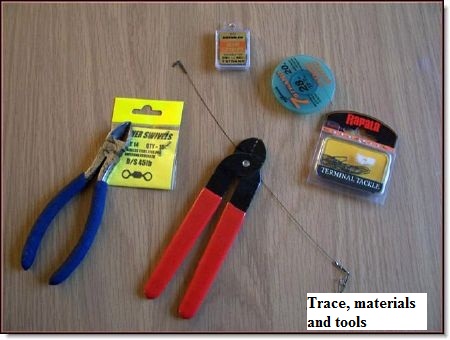 REELS: Any reel will work for pike, although a large arbour and a good disc drag will prove to be an advantage. Though not built for stamina, over a short distance, pike are very fast and explosive and a reel that has not got its drag set properly may over run. The result, a tangled mess of line and a lost fish.
REELS: Any reel will work for pike, although a large arbour and a good disc drag will prove to be an advantage. Though not built for stamina, over a short distance, pike are very fast and explosive and a reel that has not got its drag set properly may over run. The result, a tangled mess of line and a lost fish.
FLY LINES: Some people prefer shooting heads for fly-piking, I think this is now unnecessary. There are full lines specifically made for the job that are a pleasure to use. The fly lines made by Masterline (toothy critter range) are as good as any and are very affordable. To start off with, either a floater or an intermediate line (my preferred line) will prove most useful as pike target their prey from below. The ability to double haul makes the whole “pike casting experience" much easier and more pleasurable.
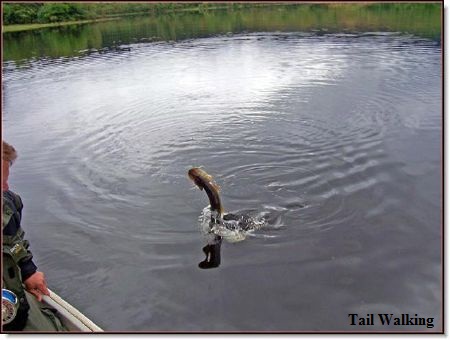 LEADER: A short leader of around 8 foot is all that’s required. Mono between 12-15lb is about right.
LEADER: A short leader of around 8 foot is all that’s required. Mono between 12-15lb is about right.
WIRE TRACE: ALWAYS USE A WIRE TRACE! Even a small pike’s teeth will cut through thick mono. You can buy traces that will do the job, but it’s far more economical and easy to make them yourself. I make my traces out off 28lb seven strand wire. I used to use the same wire in lighter breaking strains but found it kinked more easily and a kinked trace is only fit for the bin, pike aren't usually line shy anyway. The wire has a small, good quality, swivel at one end and an appropriate snap link at the other. I‘m using size 2 rap snaps at the moment. These are attached to the trace by means of crimps. For making traces some simple tools are required, some you will already have in your tool box, wire cutters, pliers, and crimping pliers.
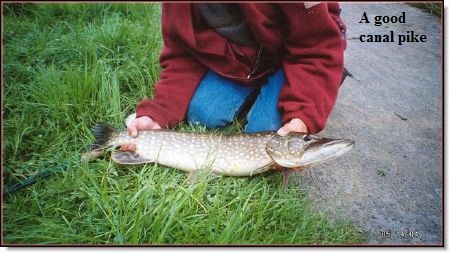 LANDING NET: Landing nets for pike are big and clumsy. I have a 42” spreader style landing net, however, it is only ever set up if the fish proves to be big. Other smaller fish are “chinned out”, I would only recommend this technique if you are used to handling pike, as it could result in injury to either yourself or the pike. If in doubt net them!
LANDING NET: Landing nets for pike are big and clumsy. I have a 42” spreader style landing net, however, it is only ever set up if the fish proves to be big. Other smaller fish are “chinned out”, I would only recommend this technique if you are used to handling pike, as it could result in injury to either yourself or the pike. If in doubt net them!
OTHER ITEMS: 10-12” forceps or long nosed pliers (for unhooking), unhooking mat, scales (just in case you get that big one), hook sharpener, hat and polarised sun glasses (for safety), fly storage (boxes zip-lock bags etc).
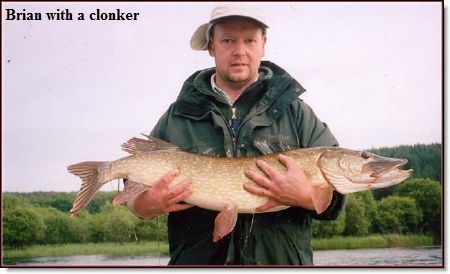 FLIES: Most modern pike flies are made from synthetic hair as they shed water more easily. However, nothing moves quite like natural hair, so I often combine a bit of both. The flies I use are all tied on size 4/0 hooks and are roughly 6-7” long. I don’t tend to tie them any smaller as I find they are at their best in these sizes (even for jacks). When I first started “fly-piking”, I did use smaller flies around 3”long tied on size 1/0 and 2/0 hooks and they did catch fish (even a few doubles) but I have now succumbed to the “Big is Beautiful” theory. I like to use a good range of colours, my most successful colours are: chartreuse/white, hot orange/white, pink/white, olive /white and flies made up solely of flash - these seem to cover the pikes tastes. Flies can be popperised (made buoyant), weighted to suit conditions / style of fishing or rattles can be added. The possibilities are endless and worthy of an article in themselves. On some waters a weed guard is extremely helpful, while on other less weedy waters it may be blamed for hindering hook-ups. I usually tie one in now through habit using a piece of 20lb nylon tied in a “V”.
FLIES: Most modern pike flies are made from synthetic hair as they shed water more easily. However, nothing moves quite like natural hair, so I often combine a bit of both. The flies I use are all tied on size 4/0 hooks and are roughly 6-7” long. I don’t tend to tie them any smaller as I find they are at their best in these sizes (even for jacks). When I first started “fly-piking”, I did use smaller flies around 3”long tied on size 1/0 and 2/0 hooks and they did catch fish (even a few doubles) but I have now succumbed to the “Big is Beautiful” theory. I like to use a good range of colours, my most successful colours are: chartreuse/white, hot orange/white, pink/white, olive /white and flies made up solely of flash - these seem to cover the pikes tastes. Flies can be popperised (made buoyant), weighted to suit conditions / style of fishing or rattles can be added. The possibilities are endless and worthy of an article in themselves. On some waters a weed guard is extremely helpful, while on other less weedy waters it may be blamed for hindering hook-ups. I usually tie one in now through habit using a piece of 20lb nylon tied in a “V”.
.jpg) THE SHREK FLY: To date this is my most successful pike fly. Originally tied in chartreuse and white, a whole lot of other successful colours have now joined my boxes. Here are the tying instructions:
THE SHREK FLY: To date this is my most successful pike fly. Originally tied in chartreuse and white, a whole lot of other successful colours have now joined my boxes. Here are the tying instructions:
Hook: 4/0 (weighted with a few turns of lead wire secured with super glue)
Tail: Arctic fox tail hair and a good helping of flash
Beard: Arctic fox tail
Wing: Flash and crinkle hair (Turrals) or slinky fibre(h20), or supreme hair in various colours
Eyes: 10mm wobbly eyes (available from craft shops) secured with Epoxy resin
Weedguard: 20lb nylon tied in a “V”(optional)
Barbless hooks or crushed barbs should be used for easy hook removal and personal safety!
A version with a rattle has been used successfully, catching a 22lb pike for my friend Brian on it’s first outing.
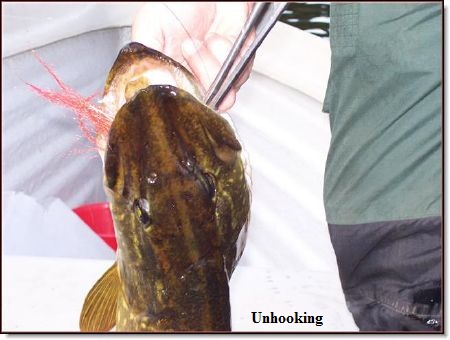 FISHING PIKE FLIES: There is nothing complicated about fly fishing for pike, The process of traditional loch style fishing for brownies is, in every way, very similar. Retrieves should be steady and varied with the occasional fast strip or lift of the rod, this often stimulates stubborn following pike to take (you can often see pike following the fly with the aid of polaroids). Light intensity and seasonal temperatures have a big part to play as to how the pike will respond. Pike like to hunt in low light conditions, so in mid-summer, an evening is a far better prospect than an afternoon. If I was to choose the best time of year and conditions for fly- piking, I would say an overcast day with a light breeze in either September or October, just as the shallows begin to cool. This is when the big pike (20+) become a realistic prospect.
FISHING PIKE FLIES: There is nothing complicated about fly fishing for pike, The process of traditional loch style fishing for brownies is, in every way, very similar. Retrieves should be steady and varied with the occasional fast strip or lift of the rod, this often stimulates stubborn following pike to take (you can often see pike following the fly with the aid of polaroids). Light intensity and seasonal temperatures have a big part to play as to how the pike will respond. Pike like to hunt in low light conditions, so in mid-summer, an evening is a far better prospect than an afternoon. If I was to choose the best time of year and conditions for fly- piking, I would say an overcast day with a light breeze in either September or October, just as the shallows begin to cool. This is when the big pike (20+) become a realistic prospect.
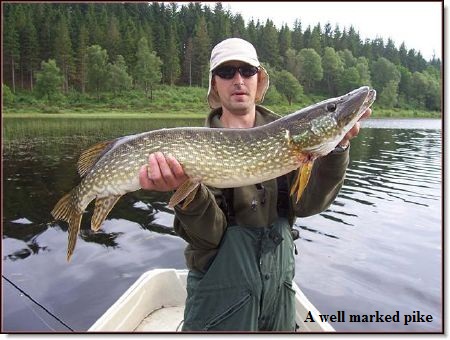 One word of warning. If you suffer from a heart condition don’t start fly-piking, the takes are often visual and can leave you seriously shaken up for days! For more hardy souls this leads to an adrenaline junkie type addiction! And a final word; please treat these creatures with the respect they deserve. They play a very important role in their ecosystem, removing the dead and injured, as well as regulating their own numbers through cannibalism!
One word of warning. If you suffer from a heart condition don’t start fly-piking, the takes are often visual and can leave you seriously shaken up for days! For more hardy souls this leads to an adrenaline junkie type addiction! And a final word; please treat these creatures with the respect they deserve. They play a very important role in their ecosystem, removing the dead and injured, as well as regulating their own numbers through cannibalism!
Colin Wilson , originally from Angus, now lives and works as a gardener in Linlithgow with his son Jack and his forgiving and tolerating wife Sylvia. His fishing tastes have widened over the years participating in and enjoying both river and loch wild trouting, fly fishing for pike and occasionally dabbling in a bit of course fishing.

